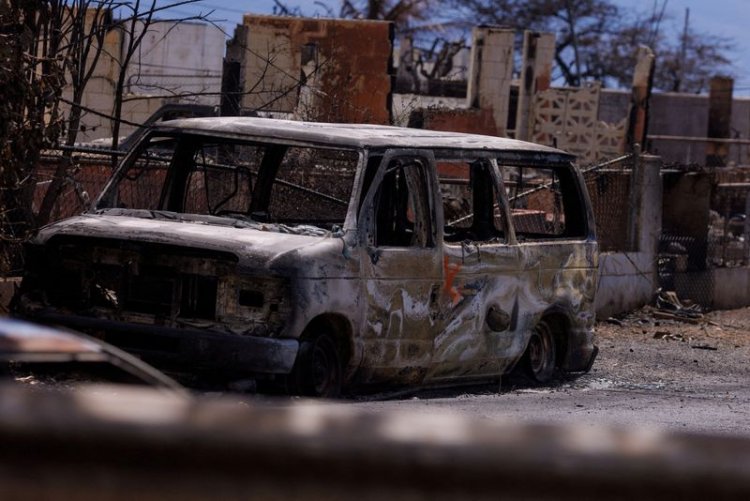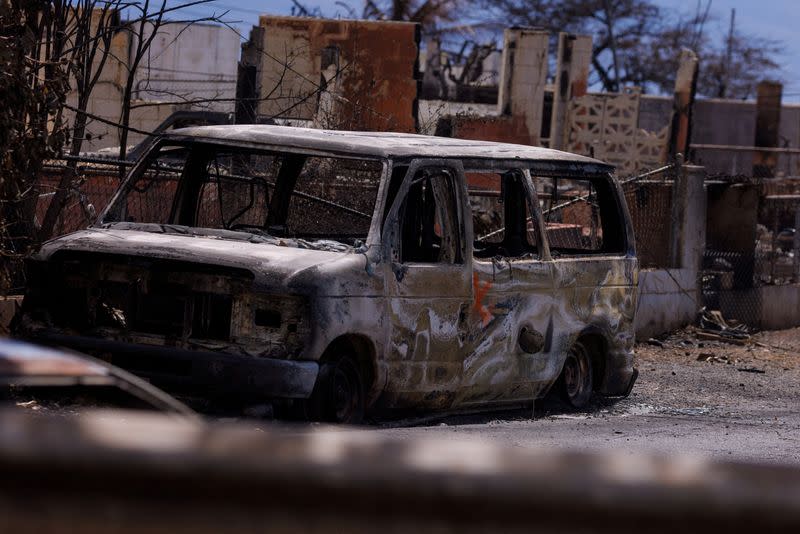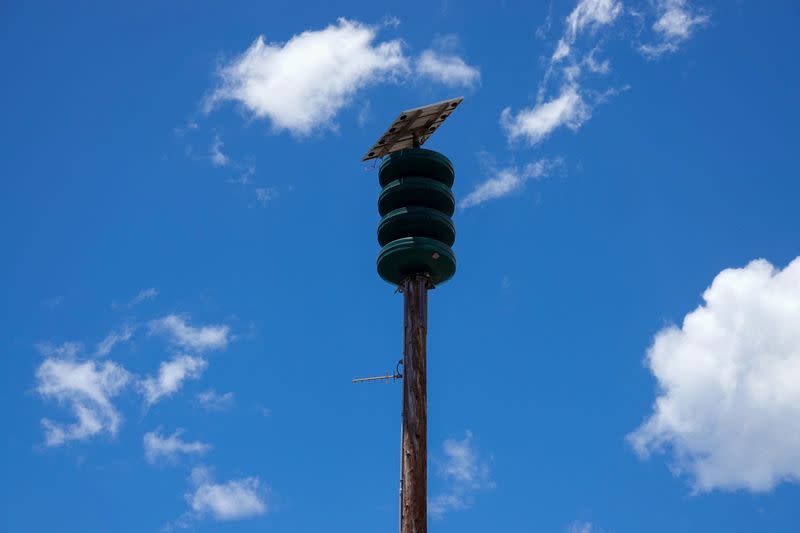'We're all Maui': Climate change tests emergency alert systems across US
1 / 2'We're all Maui': Climate change tests emergency alert systems across USFILE PHOTO: Fire damage in Lahaina on the Hawian Island of MauiBy Brad Brooks and Julia Harte(Reuters) - A fire suddenly swallows a Hawaiian town, killing scores. Wildfire smoke from Canada unexpectedly drifts across the U.S. Northeast, choking millions. Record rains surprise Vermont, triggering landslides.This summer has been one of weather extremes across the United States, a season of intense heat waves, torrential storms and runaway wildfires that have tested how well prepared public safety officials and the emergency warning systems they oversee are for the changing climate.Nowhere has that played out more visibly than on the Hawaiian island of Maui, where a small brushfire transformed into a fast-moving blaze that burned the historic town of Lahaina to the ground on Aug. 8. So unexpected and intense were the fires that some residents jumped into the ocean to avoid them because there was nowhere else to g

By Brad Brooks and Julia Harte
(Reuters) - A fire suddenly swallows a Hawaiian town, killing scores. Wildfire smoke from Canada unexpectedly drifts across the U.S. Northeast, choking millions. Record rains surprise Vermont, triggering landslides.
This summer has been one of weather extremes across the United States, a season of intense heat waves, torrential storms and runaway wildfires that have tested how well prepared public safety officials and the emergency warning systems they oversee are for the changing climate.
Nowhere has that played out more visibly than on the Hawaiian island of Maui, where a small brushfire transformed into a fast-moving blaze that burned the historic town of Lahaina to the ground on Aug. 8. So unexpected and intense were the fires that some residents jumped into the ocean to avoid them because there was nowhere else to go. At least 115 people died.
Emergency sirens on Maui, part of Hawaii's decades-old early warning system, never sounded.
As climate change increases the ferocity and frequency of extreme weather events, quickly warning the public of their arrival is more important than ever. But authorities are finding existing emergency alert systems insufficient for these new threats - sometimes with deadly results.
"We're all living in the same state that Maui was in a month ago," said Jeffrey Schlegelmilch, director of the National Center for Disaster Preparedness at Columbia University's Climate School. "We're all living in an environment that is exposed to increased hazards that we don't fully understand."
Hawaii's emergency siren system was developed in 1940 to warn of military invasions, but officials began using it to alert the public about tsunamis after one struck the Big Island in 1946, killing 159 people.
When wildfires ravaged Maui this month, authorities said they decided against activating the sirens for fear residents would assume a tsunami was coming and flee from the shore - into the fire's path.
Official websites had touted the sirens as an "all-hazard" system, suitable for various events including wildfires. Yet Maui residents said they associated them with tsunamis, according to Chris Gregg, a geology professor at East Tennessee State University who previously surveyed Hawaii residents about the sirens.
Any decision on sounding the sirens had to be made quickly. Fueled by strong winds, one fire went from "100% contained" to an inferno that devoured Lahaina in hours, a sharply compressed period for authorities more accustomed to tracking incoming hurricanes, for instance.
"A lot of our systems were built for a different climate and a different set of hazards that moved a little slower," said Hawaii Emergency Management Agency spokesperson Adam Weintraub.
He said the state is examining "other and more resilient ways that we can deal with these emerging threats."
NEW CHALLENGES
Across much of the world, warning systems for natural disasters have not evolved in response to climate change, according to Schlegelmilch.
Fires, storms, and other extreme weather events "aren't behaving the same way," he said. They not only are bigger and faster moving, but are cropping up in new places.
That can be especially dangerous in areas with emergency alert systems narrowly tailored to the types of disaster that have historically occurred there.
While each locality faces a distinctive threat landscape and needs a unique warning system, disaster management experts see some solutions that can be applied everywhere.
Instead of using "one-size-fits-all" warning systems, officials should only use sirens when their meaning is clearly understood by the public, in conjunction with notifications via TV, radio, phone call, and text message, according to Schlegelmilch.
They can also lean more heavily on experts like those in the U.S. National Weather Service to help track and predict fast-developing natural disasters.
Since a new director took over last summer, the weather service has started deploying its personnel directly into the offices of emergency responders to hasten the sharing of their expertise during "severe weather events," according to Bill Parker, the agency's meteorologist in charge in Jackson, Mississippi.
Meteorologists can help officials decide how and when to warn the public of potential disasters, according to Parker, by using metrics such as wind speeds to calculate when a wildfire might reach a residential area.
Equally important is preparing the public to anticipate the types of weather events that climate change might bring and make evacuation plans before they occur, he said.
TRIAL BY FIRE
Working out of his office in Colorado's foothills, some 3,200 miles (5,150 km) away from Maui, Boulder Office of Disaster Management Director Mike Chard knows how quickly things can go wrong when natural disasters strike.
Chard was at his post the morning of Dec. 30, 2021, when a wildfire driven by hurricane-force winds broke out in a densely populated area south of Boulder.
Boulder County had a network of sirens, but they were not used to warn of wildfires where the fire erupted. Evacuation orders were slowed because different officials had to approve them depending on the area.
Chard realized the system had to evolve "because of the type of hazards we now have - they're 'no-notice' fast-developing disasters with a lot of complexity and escalation to them and they cross jurisdictional lines."
Afterwards, he worked with other agencies to eliminate bureaucratic choke points. Now any first responder on scene can demand that alerts be sounded and evacuations ordered.
Officials also divided the eastern half of the county into numbered zones so first responders can quickly tell dispatchers which areas to be evacuated; the western part of Boulder County, where wildfires were historically more common, had already been mapped out that way.
Boulder County's sirens can now be used for wildfires. They issue both tones and spoken commands. The county also acquired a warning system that can send alerts to cellphones, fixed phone lines, emails - and even fax machines.
Without such advance planning, "you're not going to be positioned to do the things you need to do when the devil comes to your door," Chard said.
Hawaiian officials have vowed to review the Maui fire response. Experts say the state's quest for more resilient responses to climate change-fueled disasters is one every government should pursue.
"We are in a paradigm shift point with disasters everywhere, not just in the Pacific, not just in the United States," said Laura Brewington, co-director of a Hawaii-based climate adaptation research program.
(Reporting by Julia Harte and Brad Brooks; Editing by Paul Thomasch and Jonathan Oatis)
What's Your Reaction?
























